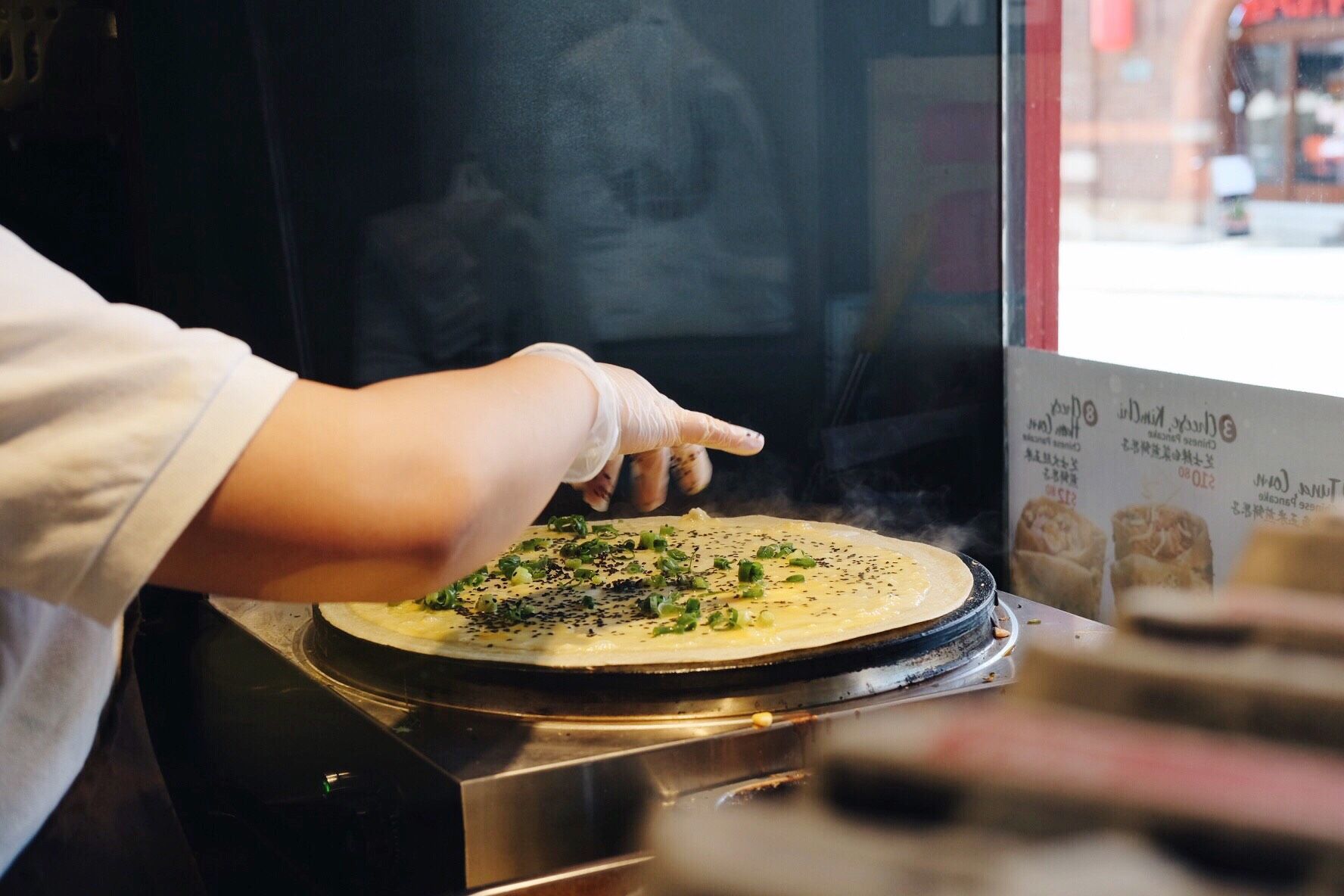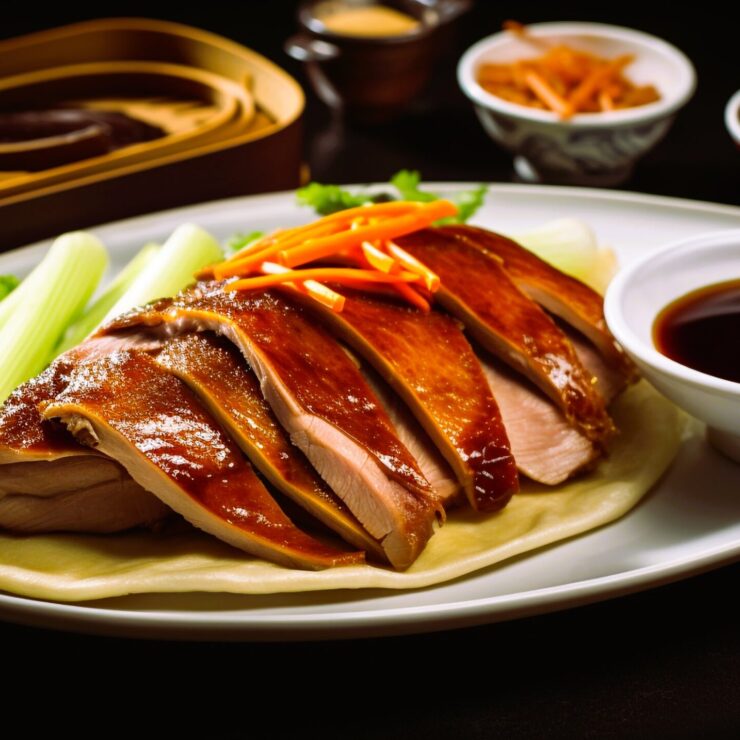Hello, food-loving travelers! If you’re planning a trip to China or simply curious about authentic Chinese street food, there’s one breakfast dish that you must add to your culinary bucket list: Jianbing, often referred to as Chinese crepes. This savory, handheld delight is a staple of morning meals across China, loved for its crispy texture, fluffy egg layer, and customizable fillings. In this detailed guide, we’ll explore the origins, preparation, cultural significance, and tips for enjoying Jianbing, especially for tourists visiting China or seeking a taste of this street food classic elsewhere.
What is Jianbing?
Jianbing is a traditional Chinese street food, often described as a savory crepe or pancake, that’s typically eaten for breakfast. Originating from northern China, particularly in regions like Shandong, Jianbing is made from a thin batter of wheat and mung bean flour, cooked on a large, flat griddle. The crepe is then layered with a beaten egg, brushed with savory sauces, and filled with a variety of ingredients like scallions, cilantro, pickled vegetables, and crispy wonton strips (known as “baocui”). Finally, it’s folded into a portable, easy-to-eat package that’s perfect for on-the-go munching.
Jianbing is not just food—it’s a cultural icon of China’s vibrant street food scene, offering a quick, affordable, and delicious start to the day. Its versatility allows for regional variations and personal customizations, making every bite a unique experience.
The History Behind Jianbing
The origins of Jianbing are believed to date back over 2,000 years to the Eastern Han Dynasty (25–220 AD), with roots in Shandong Province. Legend has it that Jianbing was invented by Zhuge Liang, a famous military strategist during the Three Kingdoms period. According to folklore, Zhuge Liang created Jianbing as a portable meal for his soldiers, using a shield as a makeshift griddle to cook thin pancakes over a fire. While the story may be apocryphal, it highlights Jianbing’s longstanding place in Chinese culinary history.
Over centuries, Jianbing evolved from a simple soldier’s ration to a beloved street food, spreading across northern China and eventually to cities like Beijing and Tianjin. Today, it’s a ubiquitous breakfast option, sold by street vendors from bustling urban centers to small towns, and has even gained international recognition as Chinese cuisine continues to captivate global foodies.
How is Jianbing Prepared?
Watching a Jianbing vendor prepare this dish is like witnessing a culinary performance. The process is quick, precise, and mesmerizing. Here’s a step-by-step look at how traditional Jianbing is made:
- Making the Batter: The batter is typically a mix of wheat flour, mung bean flour, and water, creating a thin, pourable consistency. Mung bean flour adds a subtle nutty flavor and helps achieve a tender yet slightly chewy texture.
- Cooking the Crepe: A ladle of batter is poured onto a large, hot, circular griddle and spread into a thin, even layer using a wooden or metal scraper. The crepe cooks in just a minute or two, developing a golden-brown surface.
- Adding the Egg: Once the crepe sets, a raw egg is cracked directly onto it and spread evenly across the surface. The heat from the griddle cooks the egg into a soft, custardy layer.
- Seasoning and Fillings: The vendor brushes the crepe with savory sauces like hoisin or fermented soybean paste, and sometimes a spicy chili sauce for a kick. Then, fillings are added—common options include chopped scallions, fresh cilantro, pickled mustard greens, lettuce, and a crispy fried wonton or dough strip for crunch.
- Folding and Serving: The crepe is folded into a neat rectangle or rolled up, often cut in half for easier handling, and handed over in a paper wrapper. The result is a warm, portable breakfast that’s bursting with contrasting textures and flavors.
Why is Jianbing So Special?
Jianbing stands out for several reasons, making it a must-try for tourists exploring Chinese cuisine:
- Texture Contrast: The combination of a soft, chewy crepe, fluffy egg, and crispy fillings creates a delightful mouthfeel in every bite.
- Customizable Flavors: From sweet to savory to spicy, Jianbing can be tailored to your taste. Some vendors even offer modern twists like adding cheese, ham, or sausage.
- Affordability: At just 5-10 RMB (approximately $0.70-1.50 USD) per piece in China, Jianbing is a budget-friendly option for travelers.
- Cultural Experience: Eating Jianbing from a street cart in the early morning, surrounded by locals rushing to work or school, offers an authentic glimpse into everyday life in China.
Where to Eat Jianbing as a Tourist
If you’re visiting China, Jianbing is easiest to find at street food stalls and small vendors, especially in the mornings. Here are some tips on where to look:
- Beijing: As the capital, Beijing is a Jianbing hotspot. Head to areas like Wangfujing Street or near subway stations during rush hour to find vendors with long lines—a sure sign of quality. Some popular spots include stalls near the Temple of Heaven or in the hutongs (traditional narrow alleys).
- Tianjin: Just a short train ride from Beijing, Tianjin is another Jianbing hub. The city’s version often includes a thinner crepe and unique fillings like dried shrimp or sweet bean paste.
- Shanghai: While not as traditional as in the north, Shanghai’s street food scene offers Jianbing with a southern twist, sometimes incorporating local flavors or thicker pancakes.
- Night Markets: In many Chinese cities, night markets also feature Jianbing stalls, catering to late-night snackers.
For tourists outside China, Jianbing is harder to come by but can sometimes be found in Chinatowns or at Chinese street food festivals in cities like New York, London, or Sydney. Some modern Chinese restaurants or food trucks may offer it as a novelty item, though authenticity varies.
Tip for Tourists: Look for vendors with a crowd—locals know the best spots! Don’t be afraid to point at ingredients or use simple gestures if there’s a language barrier. Most vendors are happy to customize your Jianbing.
How to Eat Jianbing Like a Local
Eating Jianbing is a casual, no-fuss experience. Here’s how to enjoy it like a local:
- Eat It Fresh: Jianbing is best right off the griddle when the crepe is warm and the crispy elements are at their peak. Avoid letting it sit too long, as it can get soggy.
- Handheld Style: It’s meant to be eaten with your hands, straight from the paper wrapper. Take small bites to avoid spillage, especially if it’s packed with fillings.
- Customize It: If the vendor offers options, don’t hesitate to ask for extra spice, no cilantro, or additional crunch. Part of the fun is making it your own.
- Pair It: Locals often pair Jianbing with a cup of warm soy milk (doujiang) or tea for a classic Chinese breakfast combo.
Cultural Note: Eating Jianbing is often a quick affair—many Chinese people grab one on their way to work or school. Embrace the fast-paced vibe and enjoy it as a true street food experience.
Jianbing Beyond China: Global Popularity
While Jianbing remains a quintessentially Chinese dish, its popularity is slowly spreading internationally, thanks to the rise of global street food culture. In recent years, food trucks and pop-up stalls in cities like Los Angeles, Toronto, and London have started offering Jianbing, often with creative twists like adding bacon, avocado, or even Nutella for a sweet version. While these modern takes may not replicate the traditional flavor, they’re helping introduce Jianbing to a wider audience.
Fun Facts About Jianbing
- A Breakfast Staple: Jianbing is so popular that many Chinese cities have hundreds of vendors, some operating 24/7 to meet demand.
- Regional Variations: In Shandong, Jianbing might be thicker and chewier, while Tianjin’s version is known for its delicate, paper-thin crepe.
- Street Food Evolution: Jianbing vendors often use custom-built carts with built-in griddles, showcasing the ingenuity of China’s street food entrepreneurs.
Tips for Tourists Trying Jianbing
- Timing: Jianbing is primarily a breakfast food, so head out early (6-9 AM) to catch vendors at their busiest. Some stalls may close by late morning.
- Hygiene: While street food is generally safe, opt for vendors with clean setups and high customer turnover to ensure freshness. Carry hand sanitizer for convenience.
- Budget: Jianbing is incredibly affordable, making it a great option for travelers on a tight budget. Keep small change handy, as many vendors don’t accept cards.
- Language Help: If you’re unsure how to order, learn a simple phrase like “Wo yao yige Jianbing” (I want one Jianbing) or use a translation app to communicate preferences.
Jianbing, with its savory crepe, fluffy egg, and array of fillings, is a quintessential part of China’s breakfast culture and street food heritage. For tourists, it offers a delicious and affordable way to connect with local life, whether you’re grabbing one from a bustling Beijing street stall or sampling a modern version abroad. The beauty of Jianbing lies in its simplicity, portability, and the joy of watching it being made right before your eyes.
So, on your next trip to China, wake up early, follow the sizzle of the griddle, and treat yourself to a freshly made Jianbing. It’s not just a meal—it’s a taste of tradition, a snapshot of daily life, and a memory you’ll savor long after your journey ends. Have you tried Jianbing before, or are you excited to taste it on your next adventure? Let us know in the comments!
Happy travels and happy eating!



